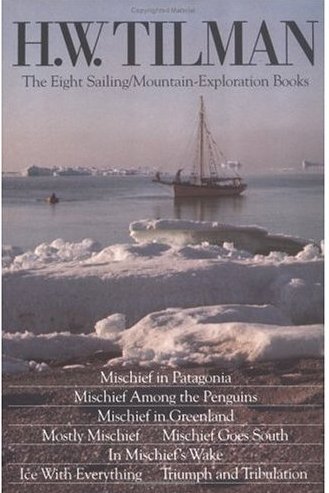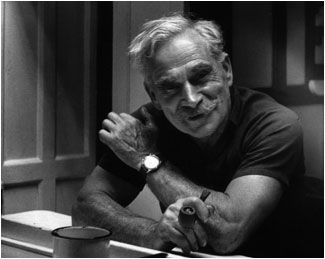 The Eight Sailing/Mountain-Exploration Books
The Eight Sailing/Mountain-Exploration Books

Includes
Mischief in Patagonia;
Mischief Among the Penguins;
Mischief in Greenland;
Mostly Mischief.
After returning from Everest in 1950, Tilman wanted to seek out new mountains to climb in unexplored regions of the world. He taught himself to sail, and bought an old Bristol Channel pilot cutter called "Mischief", one of three such wooden vessels he was to own over the next 25 years. His long voyages to extreme climates in the Arctic and Antarctic are legendary in the annals of ocean sailing.
H. W. Tilman - mountaineer, sailor and one of the great explorers of this century - was a prolific and stylish writer. His mountain activities are recorded in H. W. Tilman: The Seven Mountain-Travel Books, an earlier omnibus, and this companion volume deals with his equally enthralling sailing adventures.
· When he bought the pilot cutter "Mischief" in 1954, it was not with the intention of retiring from mountaineering, but to use the sea for access to remote mountains in high latitudes. Over the next twenty-two years "Mischief" and her successors saw regular service in distant waters, and their owner developed a whole new technique and tradition of amphibious mountaineering. His seafaring technique, like that of his mountaineering, was based on simplicity, using well-tried methods and navigational equipment that was essentially the same as that used by James Cook. He maintained that the only worthwhile innovations made in small ships in the last hundred years were the Diesel engine and Terylene rope. His seamanship was characterized by the same intelligence, cool judgment and masterly skill that had made his mountaineering exploits famous. He became an excellent navigator, with an approach more like that of a merchant sailing ship's master than a modern racing yachtsman's. The object was to arrive, not to win a race, and his ships and crews were carefully nursed through severe conditions without strain or fuss.
· The eight books collected haere are humorous, learned, devastatingly candid, and packed with information. They recount voyages to the Southern Oceans where he visited Patagonia, the Crozets, Kerguelen, Heard Island and the South Shetlands. No less important were his many trips to Greenland as well as forays to Sptizbergen, Baffin Island and other areas above the Arctic Circle. The mountaineering highlights of his seafaring career were the crossing of the Patagonian ice cap, the crossing of Bylot Island, and the ascent of Big Ben on Heard Island, where although Tilman was not in the summit party, he contributed more than any of them to the success of the expedition.
· Not all of his voyages were successful or enjoyable. A valued crew member was lost overboard during one venture. There were the sad losses of his cutters, "Mischief" and "Sea Breeze", and other occasions when crew members, unable to match Tilman's persistence, decided to desert or mutiny.
· Most of his crews were made of sterner stuff. They were rewarded with good fellowship and humor, the opportunity of learning seamanship and mountaineering from a great teacher, and a chance to see what may be done in rough waters and heavy ice in a little, old, unstrengthened ship.
· Some managed to join him on more than one voyage, including the resourceful Simon Richardson, in whose boat "En Avant", Tilman, Richardson and their crew disappeared after leaving Rio de Janeiro for Port Stanley in November 1977. What happened is a mystery but the passage to South America had been a happy one. The loss of six enterprising young men was tragic, but for Tilman at least, it was a sad but curiously fitting end, one last voyage in the best of good company.
|
|

Harold William Tilman (1898-1977).
Bill Tilman iniziò la sua attività alpinistica negli anni Trenta nell'Africa Orientale, assieme a Eric Shipton, con cui scalò il Kilimanjaro, il Ruwenzori, e aprì una nuova difficile via sul monte Kenya. Sempre con Shipton compì numerose esplorazioni e salite in Himalaya; nel 1936 scalò con N.E Odell la Nanda Devi (7816 m), la cima più alta raggiunta fino ad allora e in quegli stessi anni partecipò a tre importanti tentativi all'Everest.
Partecipò anche alla seconda guerra mondiale in Italia, aiutando i partigiani di Belluno di cui divenne cittadino onorario. Il CAI gli ha dedicato il sentiero Alta Via Tilman che collega Asiago a Falcade.
Dopo l'intervallo della seconda guerra mondiale, esplorò ripetutamente il Sinkiang e le sorgenti del Trisuli Gandaki in Nepal e guidò una spedizione all'Annapurna.
Appassionato velista, unì alpinismo e navigazione per esplorare regioni montuose e scalare montagne in Groenlandia e Patagonia. Scomparve nell'Oceano Atlantico, assieme ai cinque uomini del suo equipaggio, durante una traversata da Rio alle isole Falkland. Ha scritto sette libri di montagna ed esplorazione e sei libri sulle sue avventure di mare che puoi trovare nei due volumi ombibus The seven mountain travel books e The Eight Sailing/Mountain-Exploration Books. |